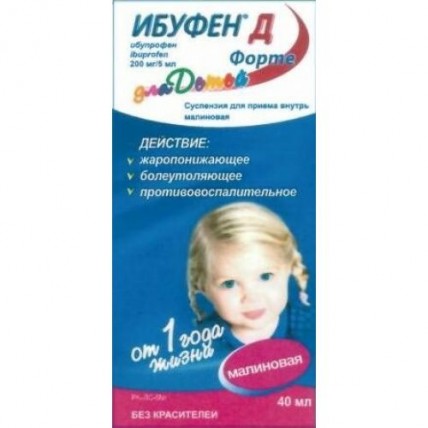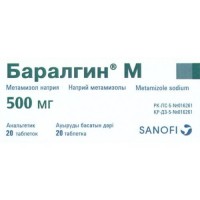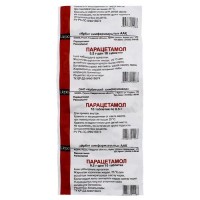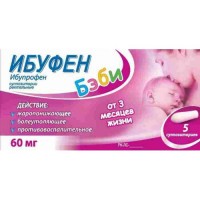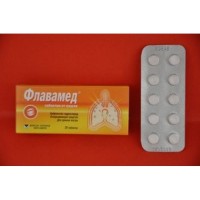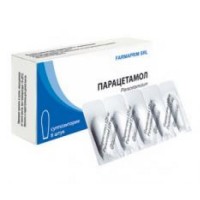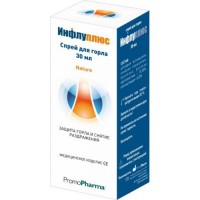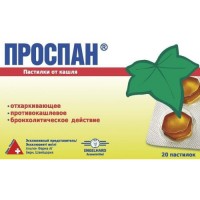Ibufen D forte 200 mg / 5 ml 40 ml of oral suspension with raspberry flavor
- $6.40
The instruction for medical use
of IBUFENUM medicine D Forte
the Trade name
Ibufenum D Forte
the International unlicensed
name Ibuprofen Dosage Form Suspension for intake, crimson 200 mg / 5 ml
Structure
of 5 ml of suspension contain
active agent - an ibuprofen of 200 mg,
excipients: a gipromelloza, xanthane gum, glycerin, Natrium benzoicum, maltit liquid, sodium citrate, citric acid monohydrate, sodium saccharinate, sodium chloride, fragrance crimson: aromatic components, triacetin (E1518), the water, water purified.
The description
Uniform suspension of white or almost white color with a raspberry smell.
Pharmacotherapeutic group
Anti-inflammatory and antirheumatic drugs. Non-steroidal anti-inflammatory drugs. Propionic acid derivatives. The ibuprofen
the ATX M01AE01 Code
the Pharmacological
Pharmacokinetics Later properties of introduction, drug is quickly soaked up from the digestive tract (DT) and distributed in an organism. The maximum concentration of an ibuprofen in serum is reached in 45 minutes after reception on an empty stomach.
Food reduces absorption of an ibuprofen, but does not reduce its biological availability and t max makes 1 2 hour. The ibuprofen approximately in 99% contacts proteins of plasma. The main proteins connecting drug is albumine. The ibuprofen and its metabolites are quickly and completely brought out of an organism by kidneys. Elimination half-life of drug makes about 2 hours.
According to not numerous data, the ibuprofen is allocated with breast milk in very low concentration.
The pharmacodynamics
the Ibuprofen is derivative propionic acid, having febrifugal, analgeziruyushchy and anti-inflammatory effect.
The mechanism of action of an ibuprofen is based on oppression of synthesis and release of prostaglandins by braking of activity of prostaglandinovy cyclooxygenase which catalyzes transformation of arachidonic acid to prostaglandins, but other mechanisms are not excluded.
Febrifugal and analgeziruyushchy actions of an ibuprofen come within 30 minutes from the moment of administration of drug.
Indications
the Increased body temperature of various genesis at:
catarrhal diseases
acute respiratory viral infections
flu
tonsillitis, pharyngitis
children's infections which are followed by fervescence
Pain syndrome of various origin of weak and moderate intensity at:
ear pains at inflammatory process on average
a toothache ear, a painful teething
of a headache, migraine
of neuralgia
of muscular pain
ostealgias and joints, owing to injuries of bodies of the movement (damage, stretching)
pains owing to injuries of soft tissues, postoperative pains
The route of administration of a dose
Is applied inside.
5 ml of suspension contain 200 mg of an ibuprofen.
Before the use to shake up before receiving uniform suspension.
Medicine is taken after a meal, washing down with a large amount of liquid.
For an exact dosage the doser in the form of the syringe is applied to packing.
The dose is established depending on age and the body weight of the child.
Usually applied single dose of the drug Ibufenum D Forte makes 7-10 mg/kg of body weight to the maximum daily dose of suspension of 30 mg/kg of body weight. Drug is appointed in single doses on the scheme given below:
The body weight
(age of the patient)
the Single dose
the Maximum daily dose
10-15 kg
(children from 1 to 3 years)
of 2.5 ml (there correspond 100 mg of an ibuprofen)
7.5 ml (there correspond 300 mg of an ibuprofen)
16-19 kg
(children from 4 to 6 years)
of 4 ml (there correspond 160 mg of an ibuprofen)
12 ml (there correspond 480 mg of an ibuprofen)
20-29 kg (children from 7 to 9 years)
of 5.0 ml (there correspond 200 mg of an ibuprofen)
15 ml (there correspond 600 mg of an ibuprofen)
30-39 kg
(children from 10 to 12 years)
of 5.0-7.5 ml (there correspond 200-300 mg of an ibuprofen)
22.5 ml (there correspond 900 mg of an ibuprofen)
More than 40 kg
(children and teenagers are more senior than 12 years and adults)
5.0-10 ml (there correspond 200-400 mg of an ibuprofen)
30 ml (there correspond 1200 mg of an ibuprofen)
It is not necessary to exceed the maximum daily dose.
It is necessary to maintain a 6-hour interval between the next doses.
If symptoms remain, amplify or if new symptoms appear, the patient has to see a doctor.
It is not necessary to use drug more than 3 days without observation of the doctor.
Drug does not contain some sugar.
Side effects
Often ( 1/1000 to 1/100):
heartburn, an abdominal pain, nausea, vomiting, a diarrhea, a meteorism, a constipation, weak bleeding from a GIT which in exceptional cases can lead to anemia
Not often ( 1/1000 to 1/100):
allergic reactions with skin rash and an itching
suffocation attacks (can occur together with a lowering of arterial pressure)
a headache, dizziness, insomnia, excitement, irritability, feeling of fatigue
of a visual disturbance
the ulceration of a GIT is possible with perforation or bleeding
a stomacace, gastritis, exacerbation of colitis and Crohn's disease
is rare ( 1/10000 to 1/1000):
sonitus
Very seldom ( 1/10000):
hemopoiesis disturbances (anemia, leukopenia, thrombocytopenia, pancytopenia, agranulocytosis).
necrotic fasciitis
heavy hypersensitivity reactions: edema of face, language and a throat, an asthma, tachycardia, arterial hypotension (anaphylaxis, a Quincke's edema or heavy shock)
psychotic reactions, a depression
heartbeat, heart failure, a myocardial infarction, a stroke
exacerbation of bronchial asthma and a bronchospasm
arterial hypertension
an esophagitis, pancreatitis, education a diaphragm of similar narrowings of intestines
a round ulcer, a perforation of the ulcer or bleeding from digestive tract, a melena, vomiting blood (sometimes with a lethal outcome, especially at elderly patients), a stomacace, gastritis, exacerbation of ulcer colitis and Crohn's disease
an acute renal failure, papillonekroz (especially at long reception), the urea associated with increase in blood serum and hypostases
of an abnormal liver function
is possible development of severe forms of skin reactions, such as bullous reactions, including a mnogoformny erythema, a toxic epidermal necrolysis, StivensaDzhonson's syndrome
symptoms of aseptic meningitis: stiff neck, a headache, nausea, vomiting, fever or disturbance of orientation, especially at patients with the preexisting autoimmune disorders (system lupus erythematosus, the mixed disease of connective tissue)
At emergence of side effects it is necessary to stop drug use.
Contraindications
hypersensitivity and also to other nonsteroid anti-inflammatory medicines
the bronchial asthma, a small tortoiseshell, rhinitis provoked by intake of acetylsalicylic acid (salicylates) or other NPVS
a digestive tract canker (peptic ulcer of a stomach and duodenum)
existence in the anamnesis of gastrointestinal bleeding or perforation, connected with therapy of NPVS
the cerebrovascular or other acute bleeding
to patients with hemorrhagic diathesis, disturbance of a hemopoiesis of not specified etiology
to patients with heavy dehydration (caused by vomiting, a diarrhea or the insufficient use of liquid)
simultaneous use of other NPVS, including specific inhibitors of cyclooxygenase-2
a heavy renal or liver failure
heart failure of heavy degree
the III trimester of pregnancy
children's age till 1 year, children with body weight less than 10 kg
Medicinal interactions
Ibufenum D Forte (just as other medicines from the NPVS group) should not be applied to an ibuprofen or other components of drug along with following medicines:
- acetylsalicylic acid, other NPVS and corticosteroids: risk of development of side effects from a GIT increases
It is necessary to be careful at simultaneous use with the following drugs:
- antihypertensive drugs and diuretics: as at simultaneous the use with NPVS decreases their efficiency
- antitrombotichesky drugs: NPVS can strengthen effect of the drugs reducing blood clotting
- lithium, a methotrexate, digoxin and Phenytoinum: NPVS can increase concentration of these drugs in plasma (it is recommended to carry out their periodic control in serum)
- a zidovudine: increase in a bleeding time at simultaneous use with an ibuprofen
- antiagregantny medicines and the selective serotonin reuptake inhibitors (SSRI) is possible: there is an increased risk of developing gastrointestinal bleeding
- mifepristone: NPVS should not be applied within 8-12 days after intake of mifepristone as NPVS can weaken its action
- takrolimusy, cyclosporine: the risk of nephrotoxic action increases at simultaneous use of an ibuprofen with these medicines
- hinolonovy antibiotics: the patients accepting a combination of NPVS and hinolona I can be subject to risk of appearance of spasms
- kaliysberegayushchy diuretics: simultaneous use with an ibuprofen can lead to development of a hyperpotassemia
- probenetsidy, Sulfinpyrazonum: these drugs can slow down removal of an ibuprofen
the Special
instructions Risk of Manifestation of Undesirable Effects it is possible to reduce if to use the smallest effective dosages, and within a short period of time, necessary for elimination of symptoms.
It is necessary to be careful at use of medicine for patients:
- with the peptic ulcer in the anamnesis which is especially complicated by bleeding or perforation
- at the same time taking other medicines, such as corticosteroids, anticoagulative drugs (warfarin), selective serotonin reuptake inhibitors or antiagregant (acetylsalicylic acid)
- with disturbances of functions of a liver and kidneys
- with bronchial asthma, hay fever, polyps in a nose or chronic obstructive disturbances of breath in the anamnesis (because of the increased risk of development of allergic reactions, in the form of a Quincke's edema or urticaria)
- with chronic inflammatory bowel diseases (nonspecific ulcer colitis, Crohn's disease)
- with a system lupus erythematosus and other diseases of connective tissue
- with uncontrollable arterial hypertension, the stagnant heart failure diagnosed by coronary heart disease, diseases of peripheral arteries and/or cardiovascular diseases in the anamnesis
- with risk factors of cardiovascular diseases (lipidemia, diabetes)
- with congenital disturbances of metabolism of porphyrines (for example, the sharp alternating porphyria)
- with disturbance of blood clotting
- directly after serious surgery.
Data of epidemiological and clinical trials allow to assume that use of an ibuprofen (especially in high doses of 2400 mg/days) and long time can be connected with small increase in risk of thrombosis of arteries.
It is necessary to stop use of drug at emergence of symptoms: skin rash, injuries of a mucous membrane or other symptoms of hypersensitivity. Heavy skin reactions, Stephens-Johnson's syndrome, a toxic epidermal necrolysis in connection with use of medicines from the NPVS group were very seldom described.
It is necessary to avoid use of drug in chicken pox as NPVS role in strengthening of manifestations of this infection is not excluded.
Elderly patients have to take with care the drug as the risk of emergence of side effects owing to use of NPVS is higher, than at young patients. Elderly patients should accept the minimum effective dosage.
Medicines from the NPVS group can mask symptoms of an infection and fever.
At use of an ibuprofen, isolated cases of a toxic amblyopia were celebrated.
At long use of analgetics there can be headaches which it is not necessary to treat the raised doses Ibufenum D Forte.
Ibufenum D Forte contains maltit liquid in this connection drug should not be used at patients with rare hereditary intolerance of fructose.
Ibufenum D Forte contains sodium benzoate in this connection it should be applied carefully at patients with hypersensitivity.
Pregnancy and period of a lactation.
There is no exhaustive information concerning safety of use of an ibuprofen for women during pregnancy. As influence of oppression of synthesis of prostaglandins on a human fruit remains to unknown, it is not recommended to apply an ibuprofen in the first and second trimester of pregnancy if it is not absolutely necessary. Use of an ibuprofen in the III trimester of pregnancy is contraindicated as it promotes premature closing of an arterial channel and can cause pulmonary hypertensia in the newborn, also drug suppresses sokratitelny uterine activity that the beginning of childbirth detains and prolongs patrimonial activity and also increases risk of bleeding at mother and the child.
The ibuprofen and its metabolites get to breast milk in very low concentration. As messages about negative consequences for babies still did not arrive, at short-term use of drug there is no need for the feeding termination by a breast.
Features of influence of medicine on ability to run the vehicle or potentially dangerous mechanisms
At administration of drug Ibufenum D Forte there can be dizziness that should be considered at control of vehicles and service of moving mechanisms.
The overdose
single reception of a dose over 400 mg can cause overdose symptoms In children. Adults have a dose capable to cause such symptoms is definitely not established. Elimination half-life during overdose makes from 1.5 to 3 hours.
Symptoms: at most of the patients accepting clinically significant doses of NPVS can be shown by nausea, vomiting, pain in epigastriums or diarrhea. Can also appear: sonitus, a headache and bleeding from a GIT. Heavy intoxication influences the central nervous system and is shown by drowsiness, and is very rare also excitement and a disorientation or a coma. Very seldom there can be attacks of spasms. During heavy intoxication there can come the metabolic acidosis, and the prothrombin time can increase. Development of an acute renal failure or injury of a liver is possible. At patients with bronchial asthma there can occur aggravation of symptoms of a disease.
Treatment: perform the symptomatic and supporting treatment. It is necessary to carry out monitoring of warm activity and the vital functions. It is necessary to consider introduction in activated carbon within 1 hour after overdose. There is no specific antidote.
A form of release and packing
On 100 ml or 40 ml of drug in the bottles from PETF with the adapter corked by the polyethylene twisting cover, safe for children, with an opening control ring.
On each bottle paste the label.
On 1 bottle place in a pack from cardboard. Put the approved instructions for medical use in packs in the state and Russian languages and the syringe for oral input.
To Store storage conditions in the place protected from light at
a temperature not higher than 25 S. Hranit out of children's reach!
A period of storage
2 years
the Period of storage after opening of primary packing of 6 months.
Not to use after an expiration date.
Prescription status
Without prescription
the Name and the country of the manufacturing organization
of Medan JSC Pharm, Poland
the Name and the country of the owner of the registration certificate
of JSC Khimfarm, the Republic of Kazakhstan
the Name and the country of the organization packer
of Medan JSC Pharm, Poland
to Develop the Address of the organization accepting in the territory of the Republic of Kazakhstan claims from consumers on quality of products (goods) of JSC Khimfarm Shymkent, Republic of Kazakhstan, Rashidov St., 81
of IBUFENUM medicine D Forte
the Trade name
Ibufenum D Forte
the International unlicensed
name Ibuprofen Dosage Form Suspension for intake, crimson 200 mg / 5 ml
Structure
of 5 ml of suspension contain
active agent - an ibuprofen of 200 mg,
excipients: a gipromelloza, xanthane gum, glycerin, Natrium benzoicum, maltit liquid, sodium citrate, citric acid monohydrate, sodium saccharinate, sodium chloride, fragrance crimson: aromatic components, triacetin (E1518), the water, water purified.
The description
Uniform suspension of white or almost white color with a raspberry smell.
Pharmacotherapeutic group
Anti-inflammatory and antirheumatic drugs. Non-steroidal anti-inflammatory drugs. Propionic acid derivatives. The ibuprofen
the ATX M01AE01 Code
the Pharmacological
Pharmacokinetics Later properties of introduction, drug is quickly soaked up from the digestive tract (DT) and distributed in an organism. The maximum concentration of an ibuprofen in serum is reached in 45 minutes after reception on an empty stomach.
Food reduces absorption of an ibuprofen, but does not reduce its biological availability and t max makes 1 2 hour. The ibuprofen approximately in 99% contacts proteins of plasma. The main proteins connecting drug is albumine. The ibuprofen and its metabolites are quickly and completely brought out of an organism by kidneys. Elimination half-life of drug makes about 2 hours.
According to not numerous data, the ibuprofen is allocated with breast milk in very low concentration.
The pharmacodynamics
the Ibuprofen is derivative propionic acid, having febrifugal, analgeziruyushchy and anti-inflammatory effect.
The mechanism of action of an ibuprofen is based on oppression of synthesis and release of prostaglandins by braking of activity of prostaglandinovy cyclooxygenase which catalyzes transformation of arachidonic acid to prostaglandins, but other mechanisms are not excluded.
Febrifugal and analgeziruyushchy actions of an ibuprofen come within 30 minutes from the moment of administration of drug.
Indications
the Increased body temperature of various genesis at:
catarrhal diseases
acute respiratory viral infections
flu
tonsillitis, pharyngitis
children's infections which are followed by fervescence
Pain syndrome of various origin of weak and moderate intensity at:
ear pains at inflammatory process on average
a toothache ear, a painful teething
of a headache, migraine
of neuralgia
of muscular pain
ostealgias and joints, owing to injuries of bodies of the movement (damage, stretching)
pains owing to injuries of soft tissues, postoperative pains
The route of administration of a dose
Is applied inside.
5 ml of suspension contain 200 mg of an ibuprofen.
Before the use to shake up before receiving uniform suspension.
Medicine is taken after a meal, washing down with a large amount of liquid.
For an exact dosage the doser in the form of the syringe is applied to packing.
The dose is established depending on age and the body weight of the child.
Usually applied single dose of the drug Ibufenum D Forte makes 7-10 mg/kg of body weight to the maximum daily dose of suspension of 30 mg/kg of body weight. Drug is appointed in single doses on the scheme given below:
The body weight
(age of the patient)
the Single dose
the Maximum daily dose
10-15 kg
(children from 1 to 3 years)
of 2.5 ml (there correspond 100 mg of an ibuprofen)
7.5 ml (there correspond 300 mg of an ibuprofen)
16-19 kg
(children from 4 to 6 years)
of 4 ml (there correspond 160 mg of an ibuprofen)
12 ml (there correspond 480 mg of an ibuprofen)
20-29 kg (children from 7 to 9 years)
of 5.0 ml (there correspond 200 mg of an ibuprofen)
15 ml (there correspond 600 mg of an ibuprofen)
30-39 kg
(children from 10 to 12 years)
of 5.0-7.5 ml (there correspond 200-300 mg of an ibuprofen)
22.5 ml (there correspond 900 mg of an ibuprofen)
More than 40 kg
(children and teenagers are more senior than 12 years and adults)
5.0-10 ml (there correspond 200-400 mg of an ibuprofen)
30 ml (there correspond 1200 mg of an ibuprofen)
It is not necessary to exceed the maximum daily dose.
It is necessary to maintain a 6-hour interval between the next doses.
If symptoms remain, amplify or if new symptoms appear, the patient has to see a doctor.
It is not necessary to use drug more than 3 days without observation of the doctor.
Drug does not contain some sugar.
Side effects
Often ( 1/1000 to 1/100):
heartburn, an abdominal pain, nausea, vomiting, a diarrhea, a meteorism, a constipation, weak bleeding from a GIT which in exceptional cases can lead to anemia
Not often ( 1/1000 to 1/100):
allergic reactions with skin rash and an itching
suffocation attacks (can occur together with a lowering of arterial pressure)
a headache, dizziness, insomnia, excitement, irritability, feeling of fatigue
of a visual disturbance
the ulceration of a GIT is possible with perforation or bleeding
a stomacace, gastritis, exacerbation of colitis and Crohn's disease
is rare ( 1/10000 to 1/1000):
sonitus
Very seldom ( 1/10000):
hemopoiesis disturbances (anemia, leukopenia, thrombocytopenia, pancytopenia, agranulocytosis).
necrotic fasciitis
heavy hypersensitivity reactions: edema of face, language and a throat, an asthma, tachycardia, arterial hypotension (anaphylaxis, a Quincke's edema or heavy shock)
psychotic reactions, a depression
heartbeat, heart failure, a myocardial infarction, a stroke
exacerbation of bronchial asthma and a bronchospasm
arterial hypertension
an esophagitis, pancreatitis, education a diaphragm of similar narrowings of intestines
a round ulcer, a perforation of the ulcer or bleeding from digestive tract, a melena, vomiting blood (sometimes with a lethal outcome, especially at elderly patients), a stomacace, gastritis, exacerbation of ulcer colitis and Crohn's disease
an acute renal failure, papillonekroz (especially at long reception), the urea associated with increase in blood serum and hypostases
of an abnormal liver function
is possible development of severe forms of skin reactions, such as bullous reactions, including a mnogoformny erythema, a toxic epidermal necrolysis, StivensaDzhonson's syndrome
symptoms of aseptic meningitis: stiff neck, a headache, nausea, vomiting, fever or disturbance of orientation, especially at patients with the preexisting autoimmune disorders (system lupus erythematosus, the mixed disease of connective tissue)
At emergence of side effects it is necessary to stop drug use.
Contraindications
hypersensitivity and also to other nonsteroid anti-inflammatory medicines
the bronchial asthma, a small tortoiseshell, rhinitis provoked by intake of acetylsalicylic acid (salicylates) or other NPVS
a digestive tract canker (peptic ulcer of a stomach and duodenum)
existence in the anamnesis of gastrointestinal bleeding or perforation, connected with therapy of NPVS
the cerebrovascular or other acute bleeding
to patients with hemorrhagic diathesis, disturbance of a hemopoiesis of not specified etiology
to patients with heavy dehydration (caused by vomiting, a diarrhea or the insufficient use of liquid)
simultaneous use of other NPVS, including specific inhibitors of cyclooxygenase-2
a heavy renal or liver failure
heart failure of heavy degree
the III trimester of pregnancy
children's age till 1 year, children with body weight less than 10 kg
Medicinal interactions
Ibufenum D Forte (just as other medicines from the NPVS group) should not be applied to an ibuprofen or other components of drug along with following medicines:
- acetylsalicylic acid, other NPVS and corticosteroids: risk of development of side effects from a GIT increases
It is necessary to be careful at simultaneous use with the following drugs:
- antihypertensive drugs and diuretics: as at simultaneous the use with NPVS decreases their efficiency
- antitrombotichesky drugs: NPVS can strengthen effect of the drugs reducing blood clotting
- lithium, a methotrexate, digoxin and Phenytoinum: NPVS can increase concentration of these drugs in plasma (it is recommended to carry out their periodic control in serum)
- a zidovudine: increase in a bleeding time at simultaneous use with an ibuprofen
- antiagregantny medicines and the selective serotonin reuptake inhibitors (SSRI) is possible: there is an increased risk of developing gastrointestinal bleeding
- mifepristone: NPVS should not be applied within 8-12 days after intake of mifepristone as NPVS can weaken its action
- takrolimusy, cyclosporine: the risk of nephrotoxic action increases at simultaneous use of an ibuprofen with these medicines
- hinolonovy antibiotics: the patients accepting a combination of NPVS and hinolona I can be subject to risk of appearance of spasms
- kaliysberegayushchy diuretics: simultaneous use with an ibuprofen can lead to development of a hyperpotassemia
- probenetsidy, Sulfinpyrazonum: these drugs can slow down removal of an ibuprofen
the Special
instructions Risk of Manifestation of Undesirable Effects it is possible to reduce if to use the smallest effective dosages, and within a short period of time, necessary for elimination of symptoms.
It is necessary to be careful at use of medicine for patients:
- with the peptic ulcer in the anamnesis which is especially complicated by bleeding or perforation
- at the same time taking other medicines, such as corticosteroids, anticoagulative drugs (warfarin), selective serotonin reuptake inhibitors or antiagregant (acetylsalicylic acid)
- with disturbances of functions of a liver and kidneys
- with bronchial asthma, hay fever, polyps in a nose or chronic obstructive disturbances of breath in the anamnesis (because of the increased risk of development of allergic reactions, in the form of a Quincke's edema or urticaria)
- with chronic inflammatory bowel diseases (nonspecific ulcer colitis, Crohn's disease)
- with a system lupus erythematosus and other diseases of connective tissue
- with uncontrollable arterial hypertension, the stagnant heart failure diagnosed by coronary heart disease, diseases of peripheral arteries and/or cardiovascular diseases in the anamnesis
- with risk factors of cardiovascular diseases (lipidemia, diabetes)
- with congenital disturbances of metabolism of porphyrines (for example, the sharp alternating porphyria)
- with disturbance of blood clotting
- directly after serious surgery.
Data of epidemiological and clinical trials allow to assume that use of an ibuprofen (especially in high doses of 2400 mg/days) and long time can be connected with small increase in risk of thrombosis of arteries.
It is necessary to stop use of drug at emergence of symptoms: skin rash, injuries of a mucous membrane or other symptoms of hypersensitivity. Heavy skin reactions, Stephens-Johnson's syndrome, a toxic epidermal necrolysis in connection with use of medicines from the NPVS group were very seldom described.
It is necessary to avoid use of drug in chicken pox as NPVS role in strengthening of manifestations of this infection is not excluded.
Elderly patients have to take with care the drug as the risk of emergence of side effects owing to use of NPVS is higher, than at young patients. Elderly patients should accept the minimum effective dosage.
Medicines from the NPVS group can mask symptoms of an infection and fever.
At use of an ibuprofen, isolated cases of a toxic amblyopia were celebrated.
At long use of analgetics there can be headaches which it is not necessary to treat the raised doses Ibufenum D Forte.
Ibufenum D Forte contains maltit liquid in this connection drug should not be used at patients with rare hereditary intolerance of fructose.
Ibufenum D Forte contains sodium benzoate in this connection it should be applied carefully at patients with hypersensitivity.
Pregnancy and period of a lactation.
There is no exhaustive information concerning safety of use of an ibuprofen for women during pregnancy. As influence of oppression of synthesis of prostaglandins on a human fruit remains to unknown, it is not recommended to apply an ibuprofen in the first and second trimester of pregnancy if it is not absolutely necessary. Use of an ibuprofen in the III trimester of pregnancy is contraindicated as it promotes premature closing of an arterial channel and can cause pulmonary hypertensia in the newborn, also drug suppresses sokratitelny uterine activity that the beginning of childbirth detains and prolongs patrimonial activity and also increases risk of bleeding at mother and the child.
The ibuprofen and its metabolites get to breast milk in very low concentration. As messages about negative consequences for babies still did not arrive, at short-term use of drug there is no need for the feeding termination by a breast.
Features of influence of medicine on ability to run the vehicle or potentially dangerous mechanisms
At administration of drug Ibufenum D Forte there can be dizziness that should be considered at control of vehicles and service of moving mechanisms.
The overdose
single reception of a dose over 400 mg can cause overdose symptoms In children. Adults have a dose capable to cause such symptoms is definitely not established. Elimination half-life during overdose makes from 1.5 to 3 hours.
Symptoms: at most of the patients accepting clinically significant doses of NPVS can be shown by nausea, vomiting, pain in epigastriums or diarrhea. Can also appear: sonitus, a headache and bleeding from a GIT. Heavy intoxication influences the central nervous system and is shown by drowsiness, and is very rare also excitement and a disorientation or a coma. Very seldom there can be attacks of spasms. During heavy intoxication there can come the metabolic acidosis, and the prothrombin time can increase. Development of an acute renal failure or injury of a liver is possible. At patients with bronchial asthma there can occur aggravation of symptoms of a disease.
Treatment: perform the symptomatic and supporting treatment. It is necessary to carry out monitoring of warm activity and the vital functions. It is necessary to consider introduction in activated carbon within 1 hour after overdose. There is no specific antidote.
A form of release and packing
On 100 ml or 40 ml of drug in the bottles from PETF with the adapter corked by the polyethylene twisting cover, safe for children, with an opening control ring.
On each bottle paste the label.
On 1 bottle place in a pack from cardboard. Put the approved instructions for medical use in packs in the state and Russian languages and the syringe for oral input.
To Store storage conditions in the place protected from light at
a temperature not higher than 25 S. Hranit out of children's reach!
A period of storage
2 years
the Period of storage after opening of primary packing of 6 months.
Not to use after an expiration date.
Prescription status
Without prescription
the Name and the country of the manufacturing organization
of Medan JSC Pharm, Poland
the Name and the country of the owner of the registration certificate
of JSC Khimfarm, the Republic of Kazakhstan
the Name and the country of the organization packer
of Medan JSC Pharm, Poland
to Develop the Address of the organization accepting in the territory of the Republic of Kazakhstan claims from consumers on quality of products (goods) of JSC Khimfarm Shymkent, Republic of Kazakhstan, Rashidov St., 81
